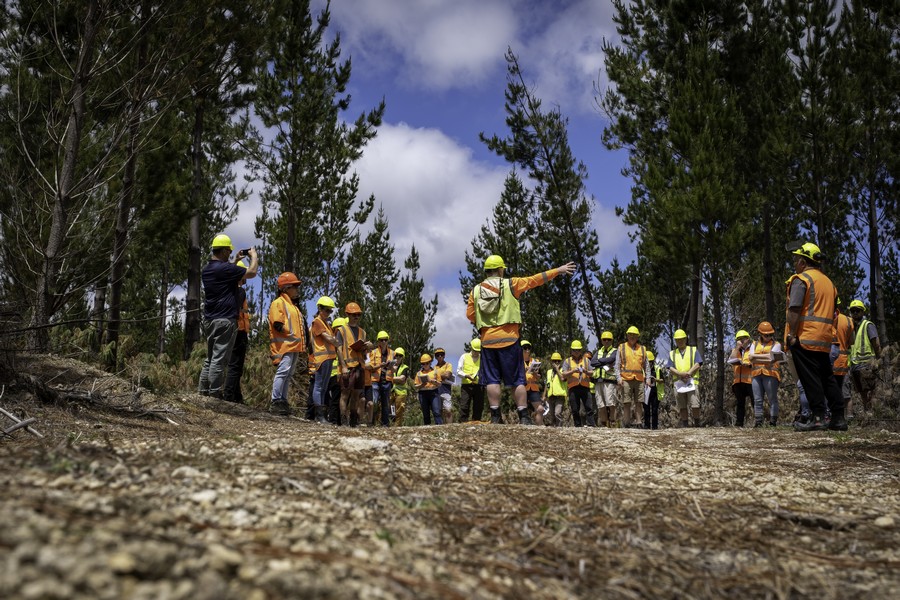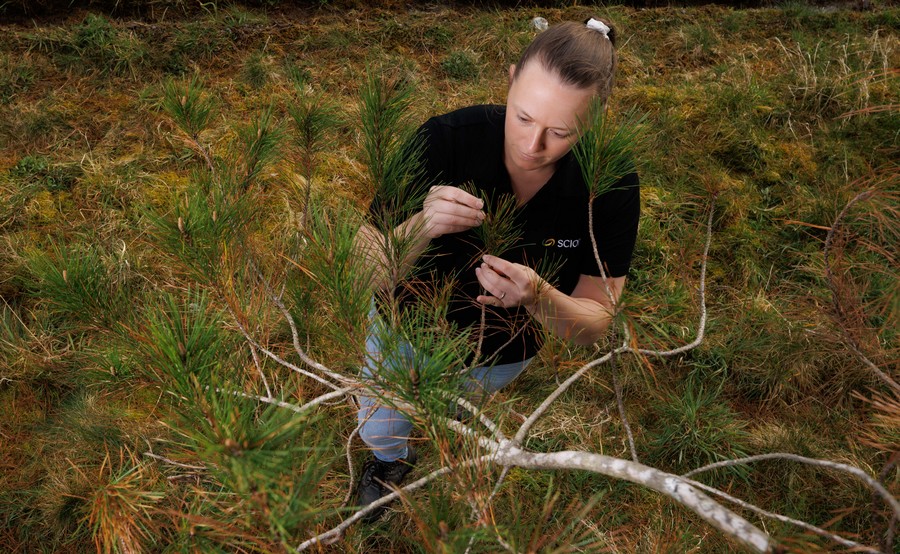Resilient Forests Research Programme
The Resilient Forests Research Programme (2020–2026) aims to enhance the radiata pine industry through heightened productivity, resilience, and risk management.
It builds upon the insights of previous Scion initiatives including the Growing Confidence in Forestry’s Future and Healthy Trees, Healthy Future programmes. Collaboratively developed with industry stakeholders, the programme seeks to establish and manage forests resilient to future uncertainties. Leveraging existing research infrastructure, it implements long-term forest management trials tailored to enhance productivity of radiata pine plantations.
It addresses key questions to ensure the forestry sector's economic, environmental, and social sustainability. By building off preceding programmes, Resilient Forests contributes to the evolution of the forestry sector, promising forests better equipped to withstand future challenges.

Background
Forests play a pivotal role in New Zealand's battle against climate change. According to the Productivity Commission, to achieve a transition to a low-emissions economy by 2050, the area of land planted in forests must increase by between 1.3 million and 2.8 million hectares. However, the critical question remains: where will the necessary investment come from, and how should we strategically plan the types and locations of these forests? As we embark on this afforestation journey, we must consider several factors, including future climate conditions, disease risks, and impacts on local communities.
This research programme aims to significantly enhance the long-term productivity, socio-economic benefits, and resilience of production forests, supporting New Zealand's transition to a low-carbon bioeconomy and achieving our carbon reduction goals. Never have ecological, social, and economic dimensions of resilience been considered simultaneously.
Forestry’s long-term horizon makes this particularly challenging, but we must be proactive. Our goal is to engineer resilience into our future forests by taking a portfolio approach to managing risks, safeguarding our assets and our communities through diversification.
About the research programme
There are three main research areas:
- Managing risk and uncertainty
- Enhancing productivity and quality (Whole-systems approach to enhancing productivity and wood quality)
- Enhancing the resilience of radiata pine forests to biotic impacts

Managing risk and uncertainty
This research area acknowledges the challenges confronting forest growers and managers amid an unpredictable future marked by socioeconomic and climatic shifts. Radiata pine forestry, centred on a single species and limited markets, faces vulnerabilities. The programme’s objective is to comprehend these risks as an initial phase toward mitigation, while also crafting effective risk management tools. By doing so, it seeks to enhance productivity and profitability while being prepared for the uncertainties ahead.
Focuses for the research programme include:
- Establishing a pilot case study and assessing the impacts of product/market diversification under future climate change scenarios.
- Developing tools and frameworks incorporating adaptive management responses to evolving climatic and socio-economic risks and uncertainty.
- Evaluating and benchmarking socially responsible investment schemes as part of the overall portfolio approach to forest management.
Contact
Grace Villamor, Scientist
Enhancing productivity and quality (Whole-systems approach to enhancing productivity and wood quality)
This area is committed to maximising the potential of radiata pine through a comprehensive approach. The research is integrated with other investigations in the Resilient Forests programme, contributing to understanding the influence of genetic diversity and denser stands on disease risk, the effects of shorter rotations on market and wood quality, and the interplay between forest management and the microbiome.
Focus areas include:
- Quantifying the extent and drivers of wood properties variation and their impacts on end-product performance.
- Developing a spatially explicit individual-tree growth simulator based on remote sensing phenotyping methods.
- Examining plant-soil-microbial processes using an expanded microbiome platform.
- Ensuring ongoing data collection from key long-term research experiments, focused on enhancing wood quality and productivity.
Contact
Peter Clinton, Principal Researcher
Enhancing the resilience of radiata pine forests to biotic impacts
This research area will strengthen the resilience of radiata pine forestry against biotic risks. The research is centred on creating tools for disease surveillance and monitoring, disease forecasting, incorporating disease considerations into growth models, refining silvicultural practices, and implementing precise disease control measures.
Focus areas include:
- Developing autonomous remote sensing tools for forest health monitoring and integration with phenotyping platforms.
- Producing a process-based epidemiological model for red needle cast that can be used to predict and manage outbreaks, investigate disease risk under climate change, and as a framework for other diseases.
- Providing near real-time data on canopy micro-climate and tree physiology to quantify disease impacts on tree growth and wood quality to support cost-benefit analysis of management activities and to integrate disease into growth models developed in the enhancing productivity and quality research area.
- Helping determine silvicultural practices that increase forest resilience to biotic risks.
Contact
Emily McLay, Forest Pathologist
Stuart Fraser, Forest Pathologist
Key findings to date
Control options for pine needle diseases: Operational trials in Kinleith and Wharerata Forests evaluated copper's effectiveness against Red Needle Cast (RNC). Sensors monitored tree growth and environmental conditions and findings showed consistent reduction in RNC severity, with copper treatment. Further research will explore spray timing and RNC's impact on tree growth for cost-benefit analysis.
Modelling an intricate disease life cycle: Research on RNC delves into understanding its life cycle and climatic drivers with an aim to develop an infection-risk model predicting disease behaviour under various conditions. This work, backed by field data and laboratory experiments, provides insights into climate influences on RNC progression. The prototype model, intended as a decision-making tool for forest managers will focus on using readily available climate data to generate accurate predictions of RNC timing and severity.
Measuring tree growth and environment: Tree sensors were deployed in Kinleith Forest and Wharerata Forest to gather data for Scion's RNC life-cycle model. Canopy sensors record environmental factors while dendrometers monitor tree growth. Second-generation wireless sensors will provide real-time data, to help understand disease impact on growth.
Productivity gains and wood properties: In Puruki Forest, researchers assessed wood quality to explore how productivity gains from site quality and genetics affect wood quality and product performance. Findings show there could be a trade-off between productivity and quality.
Boron and wood quality: National trials since 2003 examined boron's effect on wood quality. Assessments at two sites during the research programme showed site and genotype influence wood quality but boron's impact is less clear and requires further analysis.
Reporting social and environmental activities: Analysis has been undertaken to determine how corporate social responsibility is implemented in New Zealand's forestry sector compared to global practices. By examining reports of major forest owners and hosting workshops, insights into social and environmental reporting practices have emerged. There's growing acknowledgment of the need for unified reporting standards, with challenges ahead in engaging company managers in corporate social responsibility decision-making processes.
- we've produced a summary of the RNC research to date (pdf)

Benefits to New Zealand
The programme de-risks forestry’s contribution to New Zealand’s transition to a low carbon economy, providing $3.79 billion in direct economic benefits and substantial spill-over benefits.
A resilient future forest portfolio increases the likelihood that New Zealand can meet its 2050 emissions reduction targets through afforestation, worth an estimated $1.15b. This increases forestry’s contribution to New Zealand’s future bioeconomy, while minimising negative impacts on forest-associated communities. Compared with a “do nothing” scenario, increasing the resilience of the existing 1.545m ha radiata pine forest estate improves its net present value by $2.64b. A decline in this asset means that even more ambitious afforestation programmes would be needed to achieve emissions reduction targets.
Funders and collaborators
The Resilient Forests research programme is supported by the Forest Growers Levy Trust and MBIE Strategic Science Investment Fund (SSIF).
The Forest Growers Research Precision Silviculture Programme has provided in-kind funding.
Publications
Here is a list of the currently published publications for the research programme. Publications will be added as they become available.
Events
The Resilient Forests Research Programme Conference was held in June 2023 at Scion, Rotorua and Kinleith Forest.
The purpose of the conference was to inform an industry audience of our science highlights, both in terms of our discoveries but also what these will mean in the future for the industry.
Related links
Forest Growers Research’s website provides easy access to a comprehensive list of technical notes and reports associated with the Resilient Forests Programme.
- Forest Growers Research document library
- Conferences and events
- Scion hones tools to meet red needle cast (Farmer’s Weekly)
- Research aims to future-proof planted forests (Scion)
- Red needle cast: Research wages war on silent threat to NZ’s planted forests (NZ Herald)
- Copper a control option for red needle cast (NZFFA)
- Resilient Forests Conference 2023 (Scion)
- Resilient Forests infosheet (Scion)
Primary contact
Peter Clinton, Principal Researcher
